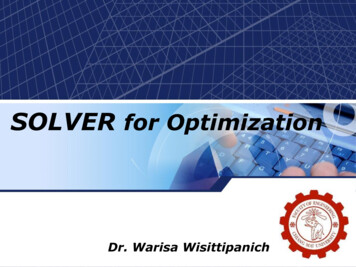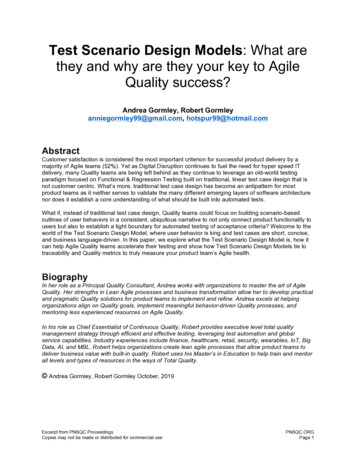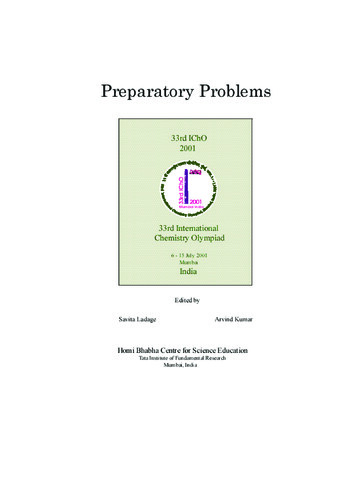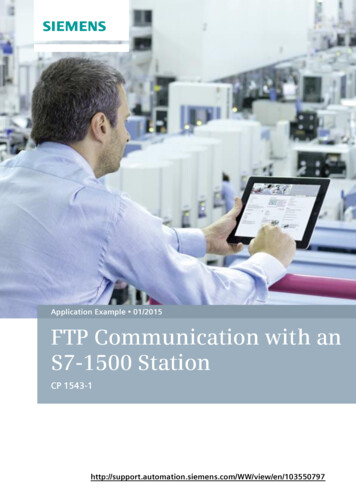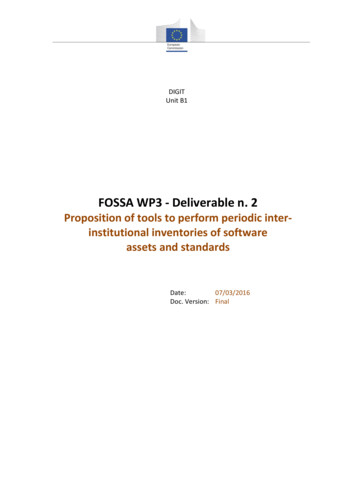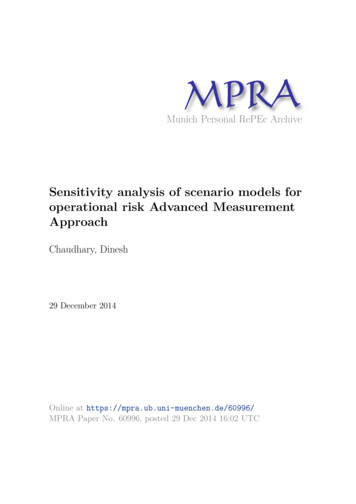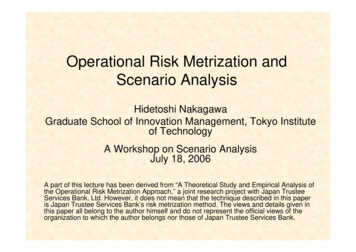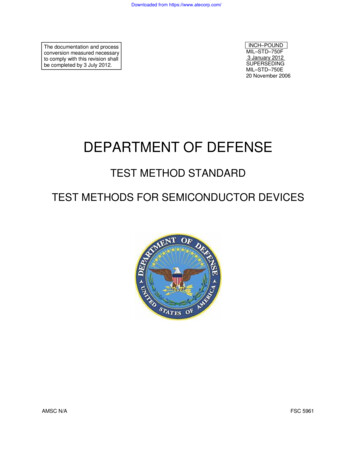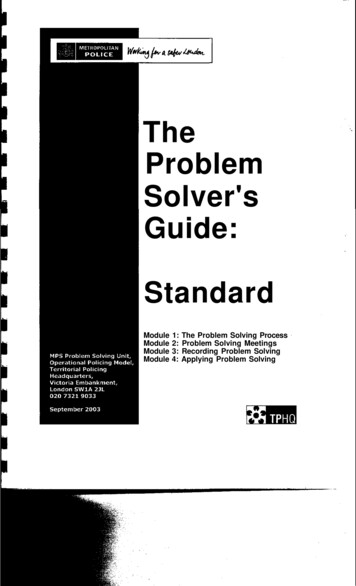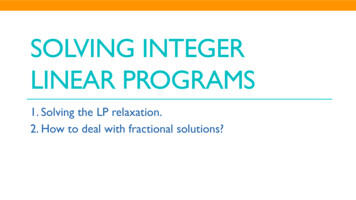
Transcription
Science Education International32(1), 23-33https://doi.org/10.33828/sei.v32.i1.3ORIGINAL ARTICLEProblem-based Scenario Method with Experiments:Determining the Prospective Science Teachers’ Biology Selfefficacy and Critical Thinking TendencyHuriye Deniş Çeliker*Department of Science Education, Education Faculty, Burdur Mehmet Akif Ersoy University, Burdur-Turkey*Corresponding author: huriyedenis@mehmetakif.edu.trABSTRACTThe purpose of this research was to investigate the effect of problem-based scenario method with experiments on the biology self-efficacyand critical thinking tendency of the prospective science teachers. In the study, pre-test and post-test experimental design without anycontrol group was used. The participants of the research were 108 second-grade prospective science teachers in an university in the westof Turkey. Throughout 12 weeks, prospective teachers were given scenarios and they designed experiments based on these scenariosin the Biology Laboratory II course. The biology self-efficacy scale and critical thinking tendency scale were used as a pre-test andpost-test. In the analysis of data, Wilcoxon Signed-Rank Test for paired samples was used through SPSS-21. The findings showed thatthere was a statistically significant difference between biology self-efficacy scale pre-test and post-test of prospective teachers in favorof the post-test. There was also a statistically significant difference in critical thinking tendency scale in favor of the post-test. In thebiology self-efficacy scale sub-factors of learning levels and problem-solving, there was a statistically significant difference on behalfof the post-test. However, there was not a statistically significant difference between pre-test and post-test concerning the laboratoryactivity sub-factor of the biology self-efficacy scale. On behalf of post-tests, there was also a statistically significant difference in criticalthinking tendency scale’s sub-factors as inquisitiveness, self-confidence, and systematicity. The results show that the problem-basedscenario method with experiment certainly contributed to the biology self-efficacy and critical thinking tendency of pre-service scienceteachers. Based on these results, it is recommended that the problem-based scenario method with experiment be used in the laboratorylessons of prospective teachers.KEY WORDS: biology self-efficacy; critical thinking; problem-based scenario method; prospective science teachersINTRODUCTIONhe perception of critical thinking and self-efficacy isimportant concepts for prospective teachers regarding21 st century skills. In the educational field, theperception of self-efficacy can be used to explain individualdifferences in teacher activities and contribute to understandingand developing teacher behaviors (Enochs and Riggs, 1990).The perception of teachers’ self-efficacy is defined as a beliefthat teachers would show necessary behaviors on successfullyperforming the teaching function. Depending on self-efficacyperceptions, teachers’ efforts, aims, and desire levels onteaching may be variable (Tschannen-Moran and Hoy, 2001).TThe self-efficacy relevant to this study is Social CognitiveTheory. This is defined as “a judgment for himself/herself aboutdesigning necessary activities to show a certain performanceand applying successfully” (Bandura, 1997, p. 3). The beliefof biology self-efficacy may be defined as those decisionsabout successfully learning the biology field (Ekici, 2009).Bandura suggests that intense self-efficacy has a positiveinfluence on the successes and happiness of individuals. Whenthe individuals, who have an intense self-efficacy, encounterScience Education International Volume 32 Issue 1a hard task, they approach the situation as a work that had tobe overcome (Askar and Umay, 2001).It has been revealed that there are differences betweenteachers, who have high and low self-efficacy, on behaviorsabout classroom arrangement, using new methods, feedbackfor students with learning disabilities, and these differencesaffect students’ motivation and successes (TschannenMoran and Hoy, 2001). The teachers, who trust theirteaching abilities and believe that learning may be led byactive teaching, show greater patience and give differentfeedback (Gibson and Dembo, 1984). This relationshipbetween teachers’ self-efficacy and student success hasbeen examined by several researchers. It is concludedthat teachers’ self-efficacy has a positive effect on studentsuccess and behavior and is directly associated withteachers’ behaviors in the classroom, being open-minded,developing positive attitudes on teaching (TschannenMoran et al., 1998). It has been noted that betweenteachers who have high and low self-efficacy there weresignificant classroom behavior differences on skills such asclassroom arrangements, feedback for students with learning23
Science Education International32(1), : Prospective teachers’ self-efficacy and critical thinkingdisabilities, and these differences caused differentiations onstudent’s success (Ozturk et al., 2002).Bandura (1997) indicated that a teacher’s self-efficacy and his/her perception had an important role in preparing a teachingenvironment that aimed to develop students cognitively.According to Aston (1984), teacher training programs canbenefit from self-efficacy tools to explain prospective teachers’beliefs for supporting them. Yet, teacher training programsshould provide the content of a certain field and more thanthe methods which can be used (Enochs and Riggs, 1990).One of the most important factors for forming the abilitiesteachers have is pre-service education. It has been argued thatthe teacher will be as adequate and efficient as the programtaken (Gokce, 1999). Therefore, prospective teachers who areeducated with an adequate and effective education processwill increase the quality of education in the future. With thebasic skills required by the age, prospective teachers can applyvarious methods in their teaching processes (Sarac, 2002).This means that teachers’ interpretations about the situationsthey encountered in professional life can be affected by theireducational experiences to include university (Dalal and Singh,1986). The problem-based scenario is one of the methods thatcan improve prospective teachers’ self-efficacy and differentskills should be applied in their teaching processes.The problem-based scenario method can help individuals tounderstand how to be specialized, to take advantage of thelives of themselves and others, and to make reasoning andlearning explicit (Schank, 2002). Some universities aim toadapt students to life and their profession, to find solutions forthe situations they might encounter using the education methodbased on learning with scenarios (Erduran-Avci and Bayrak,2013). In learning based on scenarios, stories containingpeople and events are presented for a learning purpose (Caroll,2000). There are four different scenario types: (A) Skills-basedscenarios, (B) problem-based scenarios, (C) speculative-basedscenarios, and (D) issues-based scenarios according to thecontent of the target aimed to be gained (Errington, 2003).Research has shown how the problem-based scenario methodis more effective than traditional teaching methods in termsof students’ ability to be effective and to learn by doing andexperiencing (Mariappan et al., 2003). Problem-based learning(PBL) aims to encourage student-centered learning and improvestudents’ higher-order thinking skills (Azer, 2009). PBL is anapproach that places the student at the center of the learningprocess, offers scenarios for groups to research and provideappropriate solutions, and scenarios have problems (Wynessand Dalton, 2018). The main tool of PBL is scenarios. Thesescenarios have events that increase students’ curiosity, makethem think about their reasons, and keep students’ motivation ata high-level while reaching the gains (Hatisaru and Kucukturan,2009). The scenarios should be associated with the real worldso that students have a connection with the implementationthat they will encounter in their professional life in the future(Sheridan and Kelly, 2012). In such an implementation, classes24are designed by focusing on the process of gaining ability andbehavior. The scenarios are set and produced for learning byexperience (Errington, 2003). The scenarios can be chosenfrom events that have happened or are likely to happen, orthey can be chosen from events that have not been experiencedand associated with real life (Acikgoz, 2003; Brock, 2003;Dahlgren and Oberg, 2001). Learning based on the scenariosprovides an educational environment in which attendantsare carefully selected; solve genuine work tasks or problems(Clark, 2009). The approach of learning based on scenariosis a quite significant method requiring first the transferring ofthought into the action, second turning the act into life, and finalthe individual acquiring this information from their own life(Cautreels, 2003; Ozerbas and Somuncuoglu-Ozerbas, 2015).There are studies based on a problem in a way of providing thestudent a role at this point (Stewart, 2003). The scenarios havethe characteristics of living experience for students by makingthem feel probable situations they may encounter in real-life(Yan, 2006). In this way, it improves their ability in criticalthinking (Torp and Sage, 2002).A well-designed scenario should provide students a chanceto reflect. It lets them exhibit, test, and evaluate their values(Ribchester and Healey, 2019). Research shows that not allstudents use what they have learned to solve problems of thereal world (Waterman, 1998). Learning based on a scenario fillsthe gap between theory and implementation (Meldrum, 2011;Ahmed, 2019). Furthermore, every detail that students need onadvancing in the scenario should be planned. On planning thescenario, it is necessary to work with leading experts in theirareas related to learning targets (Akins and Crichton, 2003).It is considered that the learning method based on thescenario, which activates the student, improves high-levelthinking abilities and is beneficial for teachers on teachinghard topics (Rybarczyk et al., 2007). The most significantbenefits of scenarios are to provide meaningful solution waysand interaction between learners (Garrison and Vaughan,2008). Researchers and teachers, who studied learningbased on scenarios, describe it as an approach that improveslearners’ creative thinking, imagination, creative solutions forproblems, and contains planning for the future by regardingthe mental process (Snoek, 2003; Viebahn and Hilton, 2006).They argue that these classroom interactions are factorsworking in conjunction with each other to support teacherand student performance (Wilson et al., 2002). The teachingapproach of problem-based scenario, which activates theimagination of students and teachers, provides a delightedlearning and teaching process for both teachers and students.This satisfaction is one of the conditions which are necessaryfor effective teaching. The scenario awakes the interests andimagination of people (Stomp, 2003). Those who have aneducation with scenarios learn in more detail and deeper thanothers (Ertl et al., 2006). Furthermore, the underlying logicof the approach is to learn and improve some skills throughgenuine activities (Schank et al., 1993). One of these skillsmay be critical thinking ability.Science Education International Volume 32 Issue 1
Science Education International32(1), : Prospective teachers’ self-efficacy and critical thinkingCritical thinking is a logical and reflective way of thinkingthat focuses on what to do and what to believe (Ennis, 1985).Critical thinking has been defined as the ability to control ourown mind and take responsibility (Paul, 1996), the abilityto interpret and evaluate observations, communications,information, and arguments (Fisher and Scriven, 1997). Criticalthinking is to think about thinking while performing the act ofthinking in an attempt to improve his/her thinking (Paul andElder, 2012). Critical thinkers believe that thinking deeplyand reasonably are the best way to decide what to believe,and they tend to use these methods in a variety of appropriatesituations (Fisher, 2011). While critical thinking abilities arecontaining some high-level thinking abilities, critical thinkingtendency is the motive and tendency of using critical thinkingof individuals who use this kind of thinking (Facione, 2015).Critical thinking is a purposeful judgment that requires selfregulation, resulting in interpretation, analysis, evaluation,and inference (Hajrezayi et al., 2015). PBL supports thedevelopment of students’ critical thinking skills (Al-Najaret al., 2019). It was found that students are more inclinedto critical thinking when their self-efficacy evaluations arehigh (Phan, 2010). Kezer et al. (2016) stated that there was acorrelation between critical thinking tendency and self-efficacyperception of university students. Phan (2009) found out apositive and significant relationship between self-efficacyand critical thinking. Wanga and Yi-Wub (2008) found outthat the predictive power of self-efficacy was high on usinghigh-level learning opinions such as critical thinking. Banduraand Lock (2003) defended that self-efficacy creates motivationand develops performance. Leung and Kember (2003) founda positive relationship between motivation variables such asaim tendency with critical thinking, self-efficacy belief, andeffort. Furthermore, Kuiper (2002) expressed that improvingof critical thinking benefits to confidence and developingself-efficacy. In the related literature, it was stated thatthere is a significant and positive correlation between selfefficacy beliefs and critical thinking tendency of prospectiveteachers (Cansoy and Turkoglu, 2017; Dehghani et al.,2011; Zangenehvandi et al., 2014). It was predicted that theimplementations of problem-based scenarios method withexperiments in laboratory classes of biology would contributeto the biology self-efficacy level and critical thinking tendencyof prospective science teachers.reflection with learning based on the scenario. Peranginanginet al. (2019) PBL with Karo culture context has increased themathematical problem solving skills and self-efficacy of itsapplication. Similarly, Rokhmawati et al. (2016) concludedthat the PBL model improves students’ problem solving skillsand self-efficacy.There are several studies in different learning levels of problembased scenarios method. Hursen and Gezer-Fasli (2017) setforth that learning based on the scenario is more effectivethan reflective learning in a way of academic achievement ofprospective teachers. Yet, a significant difference could notbe found between self-efficacy perceptions of groups withlearning based on the scenario and reflective learning. Dori etal. (2002) concluded that a significant improvement occurredin the knowledge level and high-level thinking abilities ofstudents by learning based on the scenario. Bardach et al.(2020) found out a significant effect on self-efficacy of theexperimental group that was implemented feedback andParticipantsScience Education International Volume 32 Issue 1When considering the related literature, it is observed thatthe PBL is used with different techniques and educationalenvironments. Unlike others, this study expects prospectivescience teachers to specify the problems in the problem-basedscenario and design an experiment as a solution. This studyprovides an example of how to use the process of problembased scenarios method with experiments in teacher training inthe biology laboratory class. It was aimed to research the effectof performing biology laboratory course with the process ofdesigning an experiment based on scenarios on biology selfefficacy and critical thinking tendency of prospective teachers.Research Questions1.2.What is the effect of problem-based scenarios methodwith experiments in biology laboratory course on biologyself-efficacy of prospective science teachers?What is the effect of problem-based scenarios methodwith experiments in biology laboratory course on criticalthinking tendency of prospective science teachers?METHODOLOGYResearch DesignIn the study, a pre-test and post-test without any control groupwas used as a quasi-experimental design (Cook and Campbell,1979). In this design, the effect of the process is tested withresearch on a single group. Measures of subjects for thedependent variable are obtained using the same subjects andtools as a pre-test before the implementation and post-test after.Within this respect, this design can be described as a singlefactor design or recursive measuring design. The significanceof the difference between the pre-test and post-test scores ofa single group in the pattern is tested (Buyukozturk et al.,2014). In the study, the process of problem-based scenarioswith experiments is used as an experimental application. Aspre-test and post-test, critical thinking tendency scale andbiology self-efficacy scale are used.The potential participants of the research were 110 secondgrade prospective science teachers in a faculty of education of astate university in the west of Turkey. This study was conductedwith 108 of the prospective teachers because two prospectiveteachers did not attempt the post-tests. Biology laboratory isa compulsory course for science teaching. There are BiologyLaboratory I (2 credits) in the fall semester and BiologyLaboratory II (2 credits) in the spring term of second gradeas an applied course. When the distribution of prospectiveteachers according to gender was examined, 78 (72.2%) werewomen and 30 (27.8%) were men.25
Science Education International32(1), : Prospective teachers’ self-efficacy and critical thinkingfactor was 0.61, and the reliability value of the systematicitysub-factor was 0.63.Data Collection ToolsBiology self-efficacy scaleThe biology self-efficacy scale which was developed by Woo(1999) and adapted into Turkish by Ekici (2009) was used. Thescale has three factors. The first one is laboratory activities, thesecond one is the learning level, and the third one is the solvingproblem. Cronbachs’ alpha coefficient of the inventory, whichis formed by 40 Likert-type items, was found to be 0.94. TheCronbachs’ alpha value was calculated as 0.95 for the pre-testof present study, and 0.96 for the post-test. Cronbachs’ alphavalues of each sub-factor of the scale are shown in Table 1.As shown in Table 1, the Cronbachs’ Alpha reliabilitycoefficient of the laboratory activity sub-factor of the originalbiology self-efficacy scale was 0.93, the Cronbachs’ Alphavalue of the learning level sub-factor was 0.90, and theCronbachs’ Alpha reliability coefficient of the problem solvingsub-factor was 0.88.Critical thinking tendency scaleThe adaptation into Turkish Culture of the scale which wasdeveloped by Facione et al. in 1998 was made by Kokdemir(2003). The final form consists 51 items and six factors as“Analyticity (ten articles),” “Open-Mindedness (12 articles),”“Inquisitiveness (nine articles),” “Self-confidence (sevenarticles),” “Truth-Seeking (seven articles),” and “Systematicity(six articles).” Cronbachs’ alpha coefficient of the inventory,which was formed by 51 Likert-type items, was found to be0.88. Cronbachs’ alpha value for the pre-test of present studywas calculated as 0.76 and the Cronbachs’ alpha value for thepost-test was calculated as 0.82. Cronbachs’ alpha values ofeach sub-factor of the inventory are shown in Table 2.In Table 2, the reliability coefficient of the analyticity subfactors of the critical thinking tendency original scale was0.75, the Cronbachs’ Alpha value of the open-mindednessfactor was 0.75, the inquisitiveness sub-factor’s Cronbachs’Alpha value was 0.78, the self-confidence sub-dimension was0.77, the truth seeking Cronbachs’ Alpha value of the sub-The Model of Problem-based Scenarios with ExperimentsProblem-based scenarios were used in this study. Hafler(1997) expresses that a scenario should be prepared in fourphases such as planning, writing, applying, and improving.Brock (2003) defined a model with eight phases (purpose;integration; authenticity; prevalence and relevance; resourcesand format for delivery; impact and interest; sequence; brevityand complexity; and modality). Scenarios were written afterthe specified models had examined.The PBL process and its stages have been studied from differentsources (Alrahlah, 2016; Hmelo-Siver, 2004; Wurdinger andCarlsen, 2010). Since problem-based scenarios applied togetherwith the experiments in the biology laboratory course, theexperiment phase was added to the process, and the applicationwas made according to the stages indicated in Figure 1.According to Figure 1, scenarios based on real or probableevents were prepared in line with the learning objectives, basedon the problem-based scenario method. Second, prospectiveteachers read the scenario to understand the content of thescenario and the topics. The third stage was the determinationof the problem. At this stage, the prospective teachers couldwrite notes to identify the problem after reading the scenarios.Prospective teachers could analyze the topic with groupdiscussion. In this way, the problem was determined and couldbe defined. In the fourth stage, the solution of the problem,the solution was searched, examined and the information wasdescribed within the reference and resources. Various resourcesand materials have been provided for prospective teachers toconduct research. In the fifth stage, prospective teachers designand implement an experiment based on the data they haveobtained as a result of their research. They tried to explain theproblem situation in the scenario by experiment. In the laststage, the researcher and prospective teachers evaluated thelearning process together. In this process, group observationTable 1: Sub‑factors, examples of items and Cronbachs’ alpha values of biology self‑efficacy scaleSub‑factors of biology self‑efficacy scale Examples of itemsLaboratory activity sub‑factorLearning level sub‑factorProblem solving sub‑factorOriginal cronbachs’ AlphaIn the biology lesson, I can carefully observe and define the result of the experimentI can understand the important terms and concepts in the biology bookI can help my friends to solve problems related to biology0.930.900.88Table 2: Sub‑factors, examples of items and Cronbachs’ alpha values of critical thinking disposition inventorySub‑factors of critical thinking tendency scale Examples of nal cronbachs’ AlphaIt disturbs me that people rely on weak ideas to defend a good thoughtExams that require thinking are better for me than those that requireonly memorizationIt would be great to study new things all my lifeI am proud to be able to think with great clarityIt is impossible to be neutral when discussing my own ideasI am known for my regular approach to complex problems0.750.750.780.770.610.63Science Education International Volume 32 Issue 1
Science Education International32(1), : Prospective teachers’ self-efficacy and critical thinkingPreparing Scenario- Scenarios based ontrue or possiblestories are createdin the direction olearning targets.Assessment- The researcher andprospective teachersevaluate the processtogether. In this process,group observation form,peer, self-evaluatioinform and class diariesmay be benefitted from.Reading Scenario- The text of thescenario is read inorder to understand thecontent of scenariosand subjects.Designing anExperiment- Prospective teachersapply experimentsby designing thosebased on the dataobtained as a resultof research. Theproblem situationin the scenariois explainedDetermining The Problem- Prospective teachers may take somenotes for determining the problem afterreading scenarios- Prospective tachers may analyze thesuject by doing group discussion. So,the problem may be determined anddefined.Solving The Problem- Within the scope of reference andsources, the solution is searched,examined and the knowledge is described.- Prospective teachers will need varioussoruce and materials to research. So,soruces should be provided such as text books,results of computer simulations, resultsof laboratory and field research, professionalmagazines, wesites, articles, brochures.Figure 1: The stages phases of problem-based scenarios with experimentsform, peer, self-assessment form, and course diaries couldbe used.As noted, this research was conducted with 108-secondgrade prospective science teachers who had been takingBiology Laboratory II course in a faculty of education. Onthe experimental group, Biology Self-efficacy Scale andCritical Thinking Tendency Scale were performed pre-testand post-test. During the implementations, there was nochange in the routine of Biology Laboratory II course andit was conducted 2 h a week. The experimental study wascontinued for 12 weeks. It lasted 14 weeks with pre-test andpost-test. In the groups, worksheets related to learning basedon the problem were used. In the activity sheets, there were14 stories including daily life problems which designed bystudents’ interest and curiosities and make them researchand investigate. According to the subject content, one or twoscenarios were given to prospective teachers in each week.The scenarios were prepared in the context of these topics:Diffusion-osmosis; structure of blood; blood groups; musclestissue, adipose tissue; observing growth; and development inliving things; characteristics of vertebrates and invertebrates;digestive system organs, nutrients and ingredients; respiratorysystem organs; circulatory system organs; excretory systemorgans; and sensory organs: Tongue and taste; sense organs:Eye and its structure. Below is a sample scenario for osmosis:Merve and her friends had gone to the sea. They had avery enjoyable day swimming in the sea for a long time.When they got out of the sea, they all noticed that theirskin was wrinkled. After waiting for a while on the beach,the wrinkles on the skin of their hands disappeared.Merve and her friends decided to have a picnic on theway back from the sea. They were preparing their mealson a table on the watered grass. Merve’s friend IrmakScience Education International Volume 32 Issue 1accidentally spilled the salt on the floor while trying toadd salt to the salad. When the salt reached the grass,the slug in the grass had already died. This situationmade them very sad.The following questions were given to prospective teachersalong with the scenario.1. What are the problem/s to be addressed in the scenario?What could be the reason for the incident occurring onthe skin of the hands of Merve and her friends? Why isthe slug dead?2. What do we know about this topic?3. Report your research on the topic.4. Design an experiment that can demonstrate this topiccontext5. Present your research and experiments on the subject inany way you want.Experiments conducted by prospective teachers regarding thisscenario are given below. The prospective teachers worked ingroups. Some experiments were preferred and conducted bymore than one group.Experiment 1: The prospective teachers used dried semipermeable animal intestines, distilled water, lugol solution,benedikt solution, starch solution, glucose solution, two beakers,a standing holder and a spirit stove, and after waiting 24 h, theywere informed about diffusion have done their experiments.Experiment 2: The prospective teachers carried out theirexperiments in which they observed plasmolysis anddeplasmolysis phenomena with onion skin, pure water,concentrated saline solution, slide, coverslip, and microscope.Experiment 3: With the osmosis experiment in potatoes,prospective teachers; they carved the inside of boiled and two27
Science Education International32(1), : Prospective teachers’ self-efficacy and critical thinkingraw potatoes. They concentrated the environment by puttingsalt into one of the boiled potatoes and one of the raw potatoes.They did not add salt to the third raw potato. They placed threepotatoes in their water baths. They observed the passage ofwater according to the density difference because of osmosis,and the osmosis phenomenon in living and non-living cells.Experiment 4: The prospective teachers kept the outer shellof an egg made up of calcium in vinegar to dissolve it. Itis a concentrated solution of protein and water in the eggmembrane, whose shell has disappeared. They observedosmosis by doing the experiments in which they observedthe volumetric change of the egg in distilled water andconcentrated salt in water.Experiment 5: The prospective teachers filled a container withpure water. Then, they dipped a funnel with sugar water insidethis container, which they sealed with selectively permeableanimal intestine in a wide part. They observed the liquidpassage in the narrow section of the funnel.Experiment 6: The prospective teachers observed thejellybeans by waiting in water. Here, the gelatin of the sugaracts as a semi-permeable membrane, so water can enter thesugar, but the sugar and the dye are much more difficult to getout of the sugar.Experiment 7: The prospective teachers used one (or two)jars, paper towels, rubber bands, and food coloring for thisexperiment. They filled a jar with water and attached a papertowel (with a rubber band) to the mouth of the jar. Hence, theymade a water-filled reservoir that would hang over the waterand add food coloring. They dropped a few drops of foodcoloring into the chamber and observed.Experiment 8: The prospective teachers put the vanilla into theballoon and infla
The belief of biology self-efficacy may be defined as those decisions about successfully learning the biology field (Ekici, 2009). Bandura suggests that intense self-efficacy has a positive influence on the successes and happiness of individuals. . biology self-efficacy; critical thinking; problem-based scenario method; prospective science .
